Unit 5 Amazing things Task课件(共20张PPT)
文档属性
| 名称 | Unit 5 Amazing things Task课件(共20张PPT) | 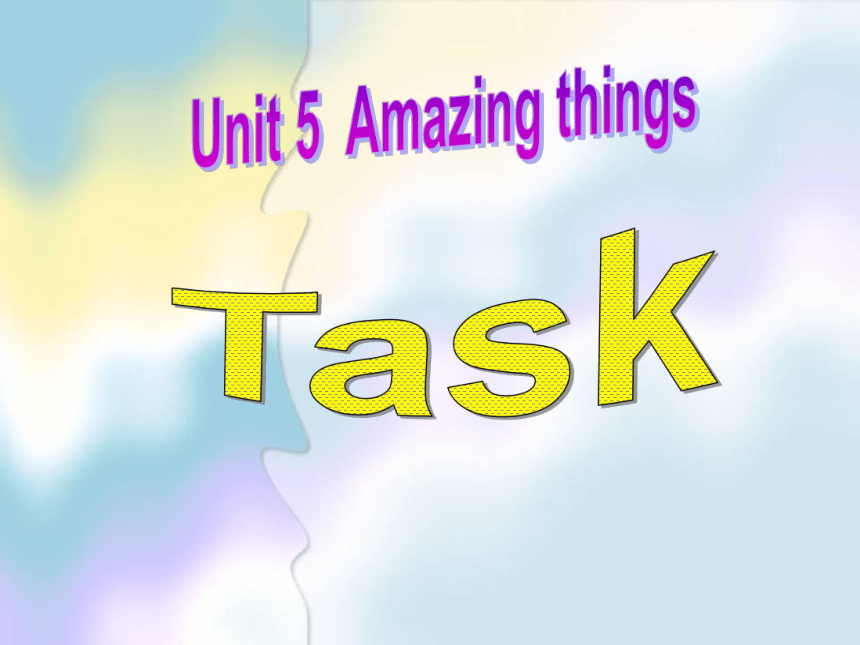 | |
| 格式 | zip | ||
| 文件大小 | 1.0MB | ||
| 资源类型 | 教案 | ||
| 版本资源 | 牛津译林版 | ||
| 科目 | 英语 | ||
| 更新时间 | 2021-04-21 10:55:05 | ||
图片预览

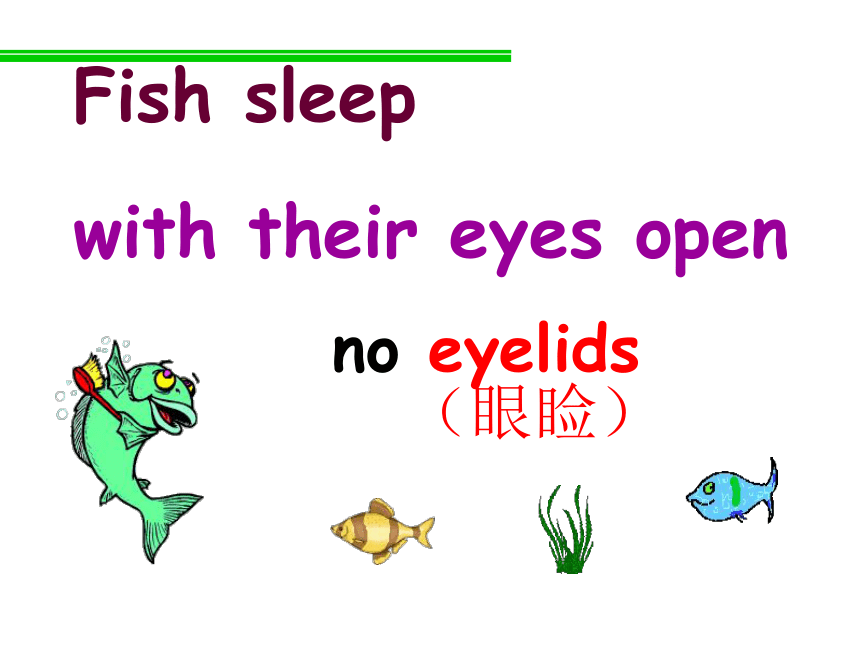
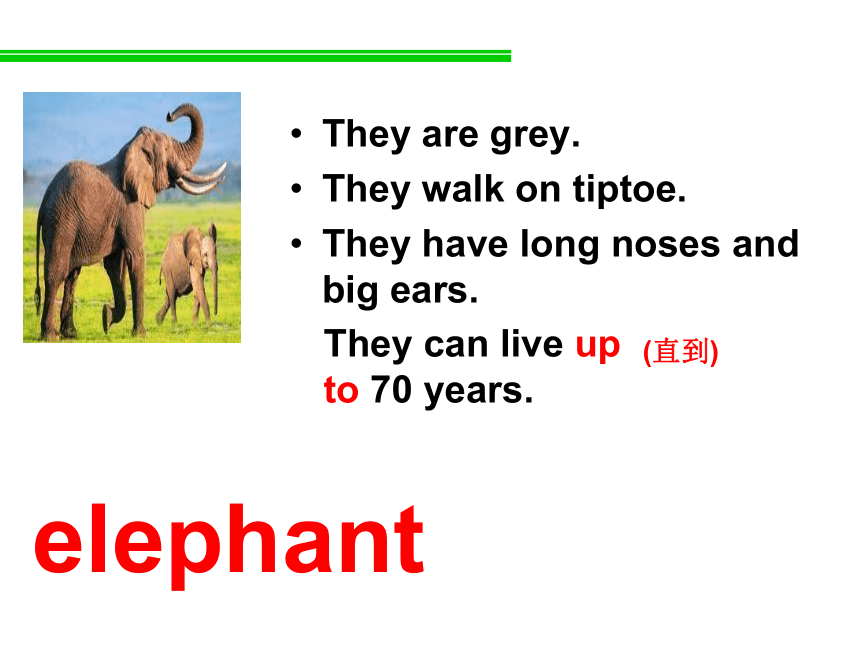
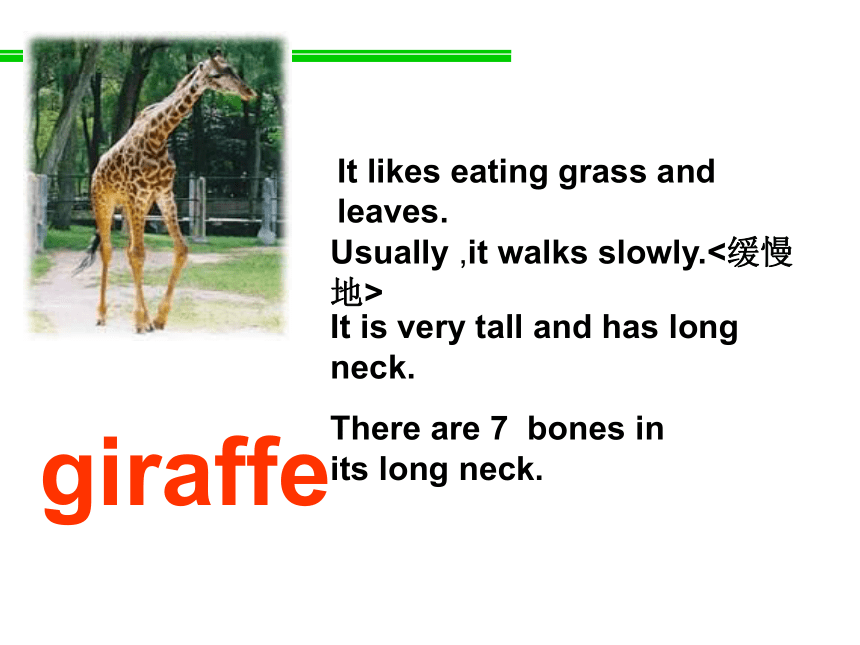
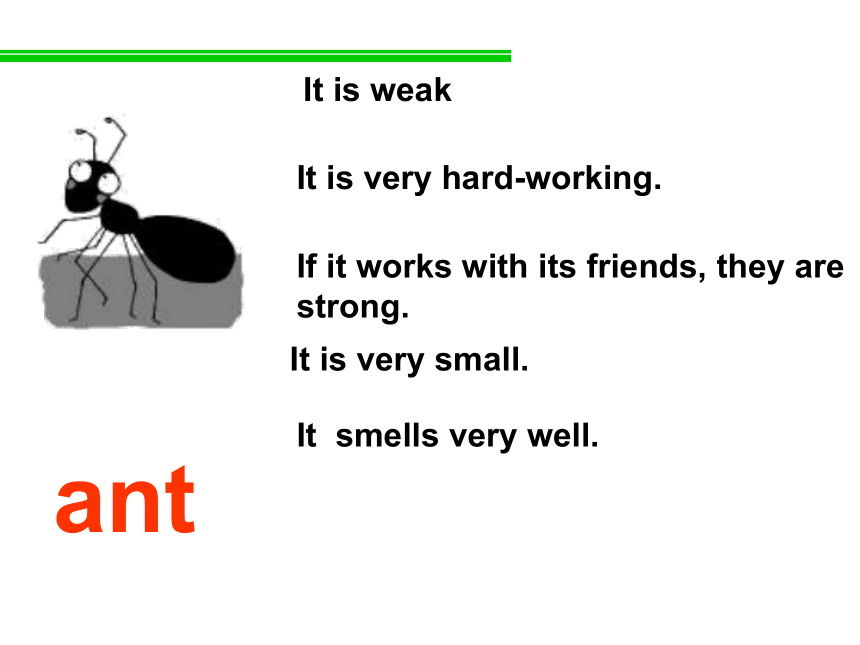
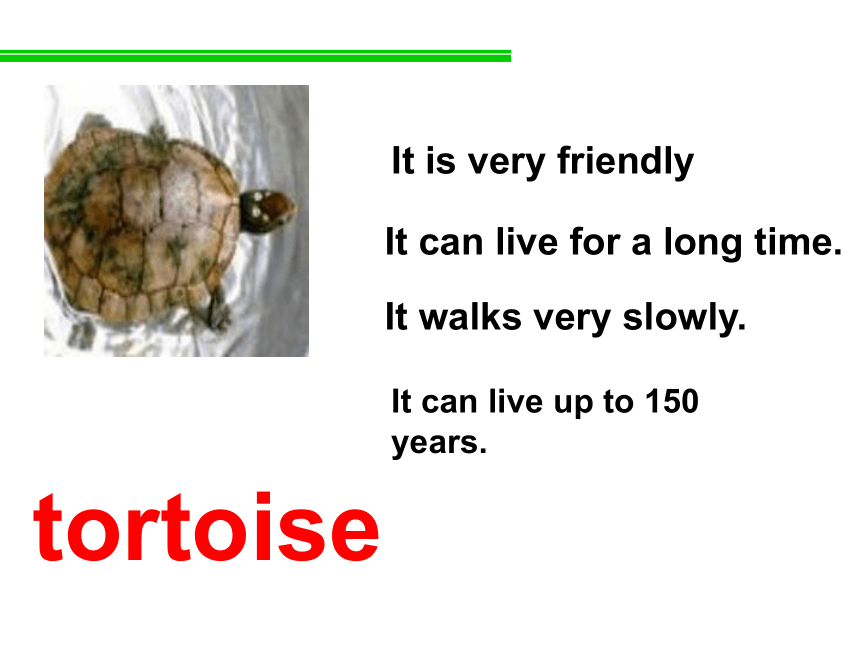

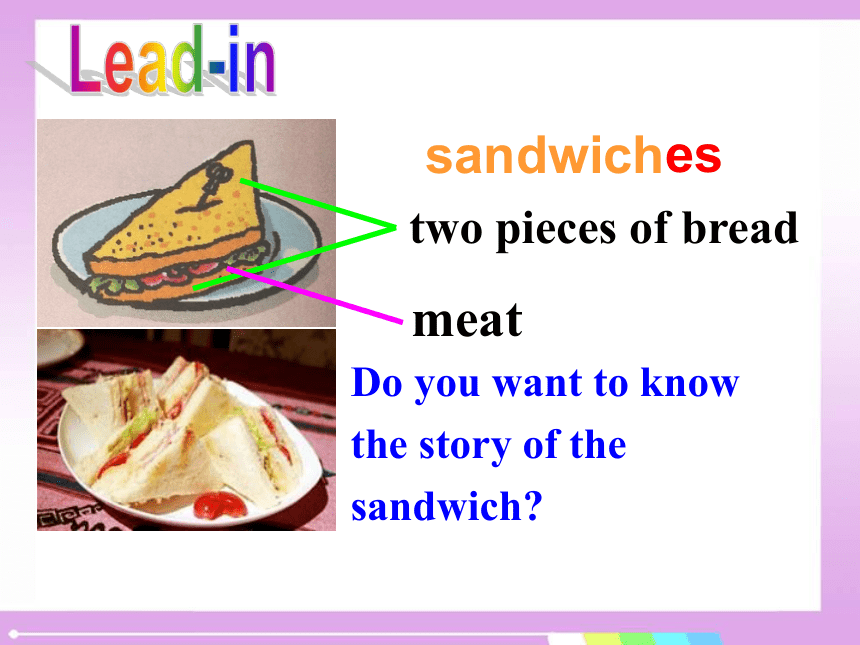
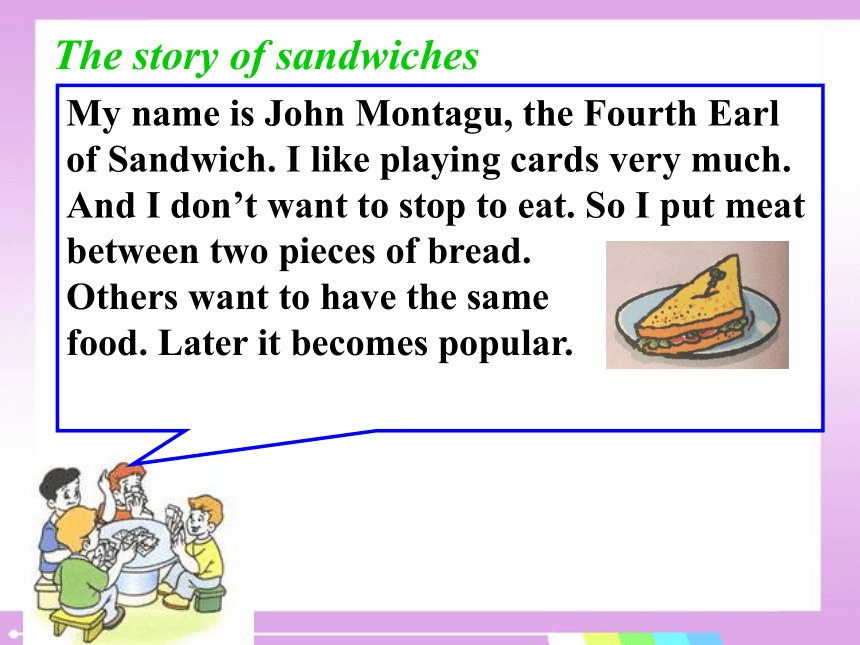
文档简介
(共20张PPT)
no
eyelids
Fish
sleep
with
their
eyes
open
(眼睑)
They
are
grey.
They
walk
on
tiptoe.
They
have
long
noses
and
big
ears.
elephant
They
can
live
up
to
70
years.
(直到)
It
likes
eating
grass
and
leaves.
Usually
,it
walks
slowly.<缓慢地>
It
is
very
tall
and
has
long
neck.
giraffe
There
are
7
bones
in
its
long
neck.
ant
It
is
very
hard-working.
It
is
weak
It
is
very
small.
If
it
works
with
its
friends,
they
are
strong.
It
smells
very
well.
It
walks
very
slowly.
It
can
live
for
a
long
time.
It
is
very
friendly
tortoise
It
can
live
up
to
150
years.
camel
It
can
live
without
water
for
a
long
time.
sandwich
two
pieces
of
bread
es
meat
Do
you
want
to
know
the
story
of
the
sandwich?
My
name
is
John
Montagu,
the
Fourth
Earl
of
Sandwich.
I
like
playing
cards
very
much.
And
I
don’t
want
to
stop
to
eat.
So
I
put
meat
between
two
pieces
of
bread.
Others
want
to
have
the
same
food.
Later
it
becomes
popular.
The
story
of
sandwiches
Sandwich
1.
got
its
name
from
a
man
called
John
Montagu,
the
Fourth
Earl
of
Sandwich
loved
playing
cards
very
much
did
not
want
to
stop
for
meals
put
meat
between
two
pieces
of
bread
others
wanted
to
eat
the
same
food
later
became
popular
all
over
the
world
We
live
in
a
wonderful
world
with
a
lot
of
amazing
things.
Many
people
like
sandwiches,
but
do
you
know
anything
about
this
kind
of
food?
Sandwich
got
its
name
form
a
man
called
John
Montagu,
the
Fourth
Earl
of
Sandwich.
The
man
loved
playing
cards
with
his
friends
very
much.
He
did
not
want
to
stop
for
meals,
so
he
put
meat
between
two
pieces
of
bread.
Soon
others
wanted
to
eat
the
same
food,
so
they
asked
for
a
“sandwich”.
Later
the
food
became
popular
all
over
the
world.
Isn’t
that
amazing?
Introduction
开头
Body
主体
(1-5小点)
Conclusion
结尾
(第6小点)
Sample
passage
1926
the
first
TV
show
by
John
Baird
in
the
UK
about
2,000
TVs
in
use
1935
TVs
can
be
as
large
as
152
inches
now
in
China,
in
1987,
about
29
TVs
per
100
families,
but
now
most
families
have
at
least
one
TV
TV
1.
the
first
TV
show
in
the
UK
in
1926
2.
by
1935,
about
2,000
TVs
in
use
3.
in
China,
in
1987,
about
29
TVs
per
100
families,
but
mow
most
families
have
at
least
one
TV
4.
now
TVs
can
be
as
large
as
152
inches
We
live
in
a
wonderful
world
with
a
lot
of
amazing
things.
Many
people
like
sandwiches,
but
do
you
know
anything
about
this
kind
of
food
?
Sandwich
got
its
name
form
a
man
called
John
Montagu,
the
Fourth
Earl
of
Sandwich.
The
man
loved
playing
cards
with
his
friends
very
much.
He
did
not
want
to
stop
for
meals,
so
he
put
meat
between
two
pieces
of
bread.
Soon
others
wanted
to
eat
the
same
food,
so
they
asked
for
a
“sandwich”.
Later
the
food
became
popular
all
over
the
world.
Isn’t
that
amazing?
Introduction
开头
Body
主体
Conclusion
结尾
TVs
thing
The
first
TV
show
in
the
UK
in
1926.
There
were
about
2,000
TVs
in
use
by
1935.
In
China,
there
were
about
29
TVs
per
100
families
in
1987.
But
mow
most
families
have
at
least
one
TV.
And
now
TVs
can
be
as
large
as
152
inches.
Now
TVs
Try
to
write
a
passage
about
TVs.
1.
play
cards
打牌
play的宾语如果是体育类活动,
不能用冠词the;
如果是乐器类宾语,
则必须加上冠词the。
打篮球
打排球
踢足球
打网球
打棒球
打羽毛球
弹钢琴
拉小提琴
弹吉他
play
basketball
play
volleyball
play
football
play
tennis
play
baseball
play
badminton
play
the
piano
play
the
violin
play
the
guitar
2.
as…as
翻译为“像……一样”,中间必须接形容词或者副词的原形。否定形式是
not
as
…
as
或者not
so
…
as。
我的书包和你的一样新。
我的书包不如你的新。
Lucy和她妹妹跑得一样快。
Lucy不如她妹妹跑得快。
My
schoolbag
is
as
new
as
yours.
My
schoolbag
isn’t
as/so
new
as
yours.
Lucy
runs
as
fast
as
her
sister.
Lucy
doesn’t
run
as/so
fast
as
her
sister.
1.
一个叫做John的人
2.
停下来吃饭
3.
吃一样的食物
4.
全世界
5.
每100个家庭
6.
像……一样大
7.
在两片面包之间
8.
非常喜欢打牌
9.
在使用中
10.
至少一台电视
a
man
called
John
stop
for
meals
eat
the
same
food
all
over
the
world
per
100
families
as
large
as
between
two
pieces
of
bread
love
playing
cards
very
much
be
in
use
at
least
one
TV
Important
phrases
The
world
is
full
of
amazing
things.
Just
enjoy
your
every
day
and
love
the
happy
life!
Homework
Choose
an
amazing
thing
and
write
a
story
about
it.
2.
Review
the
whole
unit.
no
eyelids
Fish
sleep
with
their
eyes
open
(眼睑)
They
are
grey.
They
walk
on
tiptoe.
They
have
long
noses
and
big
ears.
elephant
They
can
live
up
to
70
years.
(直到)
It
likes
eating
grass
and
leaves.
Usually
,it
walks
slowly.<缓慢地>
It
is
very
tall
and
has
long
neck.
giraffe
There
are
7
bones
in
its
long
neck.
ant
It
is
very
hard-working.
It
is
weak
It
is
very
small.
If
it
works
with
its
friends,
they
are
strong.
It
smells
very
well.
It
walks
very
slowly.
It
can
live
for
a
long
time.
It
is
very
friendly
tortoise
It
can
live
up
to
150
years.
camel
It
can
live
without
water
for
a
long
time.
sandwich
two
pieces
of
bread
es
meat
Do
you
want
to
know
the
story
of
the
sandwich?
My
name
is
John
Montagu,
the
Fourth
Earl
of
Sandwich.
I
like
playing
cards
very
much.
And
I
don’t
want
to
stop
to
eat.
So
I
put
meat
between
two
pieces
of
bread.
Others
want
to
have
the
same
food.
Later
it
becomes
popular.
The
story
of
sandwiches
Sandwich
1.
got
its
name
from
a
man
called
John
Montagu,
the
Fourth
Earl
of
Sandwich
loved
playing
cards
very
much
did
not
want
to
stop
for
meals
put
meat
between
two
pieces
of
bread
others
wanted
to
eat
the
same
food
later
became
popular
all
over
the
world
We
live
in
a
wonderful
world
with
a
lot
of
amazing
things.
Many
people
like
sandwiches,
but
do
you
know
anything
about
this
kind
of
food?
Sandwich
got
its
name
form
a
man
called
John
Montagu,
the
Fourth
Earl
of
Sandwich.
The
man
loved
playing
cards
with
his
friends
very
much.
He
did
not
want
to
stop
for
meals,
so
he
put
meat
between
two
pieces
of
bread.
Soon
others
wanted
to
eat
the
same
food,
so
they
asked
for
a
“sandwich”.
Later
the
food
became
popular
all
over
the
world.
Isn’t
that
amazing?
Introduction
开头
Body
主体
(1-5小点)
Conclusion
结尾
(第6小点)
Sample
passage
1926
the
first
TV
show
by
John
Baird
in
the
UK
about
2,000
TVs
in
use
1935
TVs
can
be
as
large
as
152
inches
now
in
China,
in
1987,
about
29
TVs
per
100
families,
but
now
most
families
have
at
least
one
TV
TV
1.
the
first
TV
show
in
the
UK
in
1926
2.
by
1935,
about
2,000
TVs
in
use
3.
in
China,
in
1987,
about
29
TVs
per
100
families,
but
mow
most
families
have
at
least
one
TV
4.
now
TVs
can
be
as
large
as
152
inches
We
live
in
a
wonderful
world
with
a
lot
of
amazing
things.
Many
people
like
sandwiches,
but
do
you
know
anything
about
this
kind
of
food
?
Sandwich
got
its
name
form
a
man
called
John
Montagu,
the
Fourth
Earl
of
Sandwich.
The
man
loved
playing
cards
with
his
friends
very
much.
He
did
not
want
to
stop
for
meals,
so
he
put
meat
between
two
pieces
of
bread.
Soon
others
wanted
to
eat
the
same
food,
so
they
asked
for
a
“sandwich”.
Later
the
food
became
popular
all
over
the
world.
Isn’t
that
amazing?
Introduction
开头
Body
主体
Conclusion
结尾
TVs
thing
The
first
TV
show
in
the
UK
in
1926.
There
were
about
2,000
TVs
in
use
by
1935.
In
China,
there
were
about
29
TVs
per
100
families
in
1987.
But
mow
most
families
have
at
least
one
TV.
And
now
TVs
can
be
as
large
as
152
inches.
Now
TVs
Try
to
write
a
passage
about
TVs.
1.
play
cards
打牌
play的宾语如果是体育类活动,
不能用冠词the;
如果是乐器类宾语,
则必须加上冠词the。
打篮球
打排球
踢足球
打网球
打棒球
打羽毛球
弹钢琴
拉小提琴
弹吉他
play
basketball
play
volleyball
play
football
play
tennis
play
baseball
play
badminton
play
the
piano
play
the
violin
play
the
guitar
2.
as…as
翻译为“像……一样”,中间必须接形容词或者副词的原形。否定形式是
not
as
…
as
或者not
so
…
as。
我的书包和你的一样新。
我的书包不如你的新。
Lucy和她妹妹跑得一样快。
Lucy不如她妹妹跑得快。
My
schoolbag
is
as
new
as
yours.
My
schoolbag
isn’t
as/so
new
as
yours.
Lucy
runs
as
fast
as
her
sister.
Lucy
doesn’t
run
as/so
fast
as
her
sister.
1.
一个叫做John的人
2.
停下来吃饭
3.
吃一样的食物
4.
全世界
5.
每100个家庭
6.
像……一样大
7.
在两片面包之间
8.
非常喜欢打牌
9.
在使用中
10.
至少一台电视
a
man
called
John
stop
for
meals
eat
the
same
food
all
over
the
world
per
100
families
as
large
as
between
two
pieces
of
bread
love
playing
cards
very
much
be
in
use
at
least
one
TV
Important
phrases
The
world
is
full
of
amazing
things.
Just
enjoy
your
every
day
and
love
the
happy
life!
Homework
Choose
an
amazing
thing
and
write
a
story
about
it.
2.
Review
the
whole
unit.
